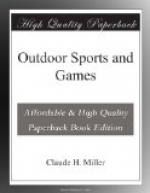Having focussed our camera and set the stop, we then close the shutter, insert the plate-holder in the back of the camera and carefully draw the slide. Omitting to pull the slide is a common mistake with beginners. We are now ready to decide just what exposure to give our plate. Rules for exposure are almost useless, but in general it may be said that the modern plates are lightning fast and that in bright sunlight at midday the average exposures will not be over 1-25 of a second. An “exposure meter” will prove to be of great assistance to a beginner, but such arrangements are not often used by experts except in doubtful cases. We soon find that we can guess at average exposures with considerable accuracy, especially if we adopt a certain brand of plate and become accustomed to its working qualities. Of course all of these speeds must be indicated on the shutter, and all we can do is to set our shutter at this point and squeeze the bulb. Correct judgment in exposure will only come after experience. In taking interior views or making pictures on dark days we shall be less likely to make a mistake than in bright sunlight. I have made two interior views, to one of which I gave ten minutes and the other an hour, with practically the same result in the negative. An over-exposed plate is flat, which means that the print will lack contrast and be unsatisfactory as a photograph.
After the bulb is squeezed and the exposure made we are ready to develop our plate and to see what result we have obtained. Of course in practice we make a number of exposures before we begin to develop. Some photographers use numbered plate-holders and keep a record of the pictures, time of day and of exposure, stop and any other items of interest. We now take the plate-holder in our dark room and prepare our developer. There are a great many developers on the market and we can scarcely make a mistake with any of them. Probably the best of all is “pyro,” but the fact that it stains the fingers is a serious objection to it for amateur use, and almost any other developer, such as metol, eikonogen or hydroquinon will be better.
These stock developers usually come in dry salts, which must be dissolved and mixed. All of this work must be done in the light so we can see that we are getting the proper proportions and that the chemicals are thoroughly in solution. The developing trays should be washed thoroughly and placed conveniently at hand so that we can find them in the dark. In addition to developers we must have what is called the “hypo” fixing bath. This is a solution of hyposulphite of soda, a chemical which is used in development and which renders the plate no longer sensitive to light, but dissolves that part which has not been acted upon by the developer. The hypo should be in a tray or box placed conveniently at hand but not so located that it will be liable to become mixed with the developer or in any way to splash or spot the plate. We must always wash the hands thoroughly after immersing a plate in the hypo before handling a fresh plate, as a very few drops will ruin a negative.




